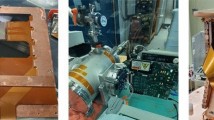Abstract
This paper introduces and describes the initial characterizations of a prototype beta-gamma coincidence detection system that utilizes a PIPSBox and two coplanar CdZnTe detectors for atmospheric radioxenon identification and nuclear test ban treaty verification. Coincidences between four independent detecting bodies are identified in real time via a custom coincidence module implemented in a field-programmable gate array. The system is compact, maintains simple readout electronics, and provides high resolution radiation detection at room temperature operation. Preliminary measurements using 137Cs and 131mXe were conducted to optimize various system parameters to achieve optimal energy resolution of key spectral features. The purpose of this research was to explore the utility of these materials and methods for radioxenon monitoring in the International Monitoring System.













Similar content being viewed by others
Notes
MCNP and Monte Carlo N-Particle are registered trademarks of Triad National Security, LLC, and are being used with permission.
References
Kalinowski MB, Tuma MP (2009) Global radioxenon emission inventory based on nuclear power reactor reports. J Environ Radioact 100:58–70. https://doi.org/10.1016/j.jenvrad.2008.10.015
Carrigan CR, Heinle RA, Hudson GB et al (1996) Trace gas emissions on geological faults as indicators of underground nuclear testing. Nature 382:528–531. https://doi.org/10.1038/382528a0
Lowrey JD, Biegalski SR, Osborne AG, Deinert MR (2013) Subsurface mass transport affects the radioxenon signatures that are used to identify clandestine nuclear tests. Geophys Res Lett 40:111–115. https://doi.org/10.1029/2012GL053885
Perkins RW, Casey LA (1996) Radioxenons: their role in monitoring a comprehensive test ban treaty. Department of Energy, Richland. DOE/RL–96-51, PNNL-SA–27750, 266641
CTBTO Preparatory Commission (2012) Overview of the verification regime. https://www.ctbto.org/verification-regime/monitoring-technologies-how-they-work/radionuclide-monitoring/. Accessed 5 July 2016
Fontaine J-P, Pointurier F, Blanchard X, Taffary T (2004) Atmospheric xenon radioactive isotope monitoring. J Environ Radioact 72:129–135. https://doi.org/10.1016/S0265-931X(03)00194-2
Browne E, Firestone RB (1986) Table of radioactive isotopes. Wiley, Berkeley
CTBTO Preparatory Commission (2012) Radionuclide monitoring. https://www.ctbto.org/verification-regime/monitoring-technologies-how-they-work/radionuclide-monitoring/. Accessed 5 July 2016
Ringbom A, Larson T, Axelsson A et al (2003) SAUNA—a system for automatic sampling, processing, and analysis of radioactive xenon. Nucl Instrum Methods Phys Res Sect Accel Spectrom Detect Assoc Equip 508:542–553. https://doi.org/10.1016/S0168-9002(03)01657-7
Dubasov YV, Popov YS, Prelovskii VV et al (2005) The ARИKC-01 automatic facility for measuring concentrations of radioactive xenon isotopes in the atmosphere. Instrum Exp Tech 48:373–379. https://doi.org/10.1007/s10786-005-0065-3
Le Petit G, Armand P, Brachet G et al (2008) Contribution to the development of atmospheric radioxenon monitoring. J Radioanal Nucl Chem 276:391–398. https://doi.org/10.1007/s10967-008-0517-x
National Nuclear Data Center. http://www.nndc.bnl.gov/. Accessed 10 Oct 2018
Schulze J, Auer M, Werzi R (2000) Low level radioactivity measurement in support of the CTBTO. Appl Radiat Isot 53:23–30. https://doi.org/10.1016/S0969-8043(00)00182-2
McIntyre J, Abel K, Bowyer T et al (2001) Measurements of ambient radioxenon levels using the automated radioxenon sampler/analyzer (ARSA). J Radioanal Nucl Chem 248:629–635
Prelovskii VV, Kazarinov NM, Donets AY et al (2007) The ARIX-03F mobile semiautomatic facility for measuring low concentrations of radioactive xenon isotopes in air and subsoil gas. Instrum Exp Tech 50:393–397. https://doi.org/10.1134/S0020441207030165
Cooper MW, McIntyre JI, Bowyer TW et al (2007) Redesigned β–γ radioxenon detector. Nucl Instrum Methods Phys Res Sect Accel Spectrom Detect Assoc Equip 579:426–430. https://doi.org/10.1016/j.nima.2007.04.092
Farsoni AT, Alemayehu B, Alhawsawi A, Becker EM (2013) A phoswich detector with compton suppression capability for radioxenon measurements. IEEE Trans Nucl Sci 60:456–464. https://doi.org/10.1109/TNS.2012.2226606
Zhang F, He Z, Xu D (2004) Analysis of detector response using 3-D position sensitive CZT gamma-ray spectrometers. IEEE Trans Nucl Sci 51:3493–3497
He Z, Sturm BW (2005) Characteristics of depth-sensing coplanar grid CdZnTe detectors. Nucl Instrum Methods Phys Res Sect Accel Spectrom Detect Assoc Equip 554:291–299. https://doi.org/10.1016/j.nima.2005.06.064
CANBERRA Industries—Worldwide leader in radiation detectors & nuclear measurement. http://www.canberra.com/#2. Accessed 8 June 2018
Griesmer JJ, Kline B, Grosholz J et al (2001) Performance evaluation of a new CZT detector for nuclear medicine: SOLSTICE. In: Nuclear science symposium conference record, 2001 IEEE. IEEE, pp 1050–1054
Le Petit G, Cagniant A, Gross P et al (2015) Spalax™ new generation: a sensitive and selective noble gas system for nuclear explosion monitoring. Appl Radiat Isot 103:102–114. https://doi.org/10.1016/j.apradiso.2015.05.019
Mirion Technologies PIPS specification sheet, Series CD, Model PIPSBOX-2x1200-500A. Canberra Industries, Meriden, CT
Czyz SA, Farsoni AT, Ranjbar L (2017) A prototype detection system for atmospheric monitoring of xenon radioisotopes. Nucl Instrum Methods Phys Res Sect Accel Spectrom Detect Assoc Equip. https://doi.org/10.1016/j.nima.2017.10.044
Le Petit G, Cagniant A, Morelle M et al (2013) Innovative concept for a major breakthrough in atmospheric radioactive xenon detection for nuclear explosion monitoring. J Radioanal Nucl Chem 298:1159–1169. https://doi.org/10.1007/s10967-013-2525-8
Foxe MP, Hayes JC, Mayer MF et al (2016) Characterization of a commercial silicon beta cell. Pacific Northwest National Lab (PNNL), Richland
Bläckberg L, Fritioff T, Mårtensson L et al (2013) Memory effect, resolution, and efficiency measurements of an Al2O3 coated plastic scintillator used for radioxenon detection. Nucl Instrum Methods Phys Res Sect Accel Spectrom Detect Assoc Equip 714:128–135. https://doi.org/10.1016/j.nima.2013.02.045
Home—Kromek. https://www.kromek.com/. Accessed 8 June 2018
Luke PN (1994) Single-polarity charge sensing in ionization detectors using coplanar electrodes. Appl Phys Lett 65:2884–2886. https://doi.org/10.1063/1.112523
Ranjbar L (2016) A two-element CZT-based radioxenon detection system for nuclear weapon test monitoring. PhD Dissertation, Oregon State University
Ranjbar L, Farsoni AT, Becker EM (2016) A CZT-based radioxenon detection system in support of the Comprehensive Nuclear-Test-Ban Treaty. J Radioanal Nucl Chem 310:969–978. https://doi.org/10.1007/s10967-016-4872-8
Czyz SA, Farsoni AT (2017) A radioxenon detection system using CdZnTe, an array of SiPMs, and a plastic scintillator. J Radioanal Nucl Chem 313:131–140. https://doi.org/10.1007/s10967-017-5287-x
Ranjbar L, Farsoni AT, Becker EM (2017) 135Xe measurements with a two-element CZT-based radioxenon detector for nuclear explosion monitoring. J Environ Radioact 169–170:221–228. https://doi.org/10.1016/j.jenvrad.2016.12.003
Becker EM (2016) Eight-channel digital spectrometer for coincidence measurements in multi-element detectors. CVT Workshop, Ann Arbor, MI
Mannino M (2017) Real-time temporal gamma spectroscopy in a field-programmable gate array. IEEE Nuclear Science Symposium & Medical Imaging Conference, Atlanta, GA
OpalKelly—Xilinx and Altera FPGA integration modules. https://opalkelly.com/. Accessed 9 Oct 2018
Foxe MP, McIntyre JI (2015) Testing of the KRI-developed silicon PIN radioxenon detector, PNNL–23995, 1258733
Cooper MW, Ely JH, Haas DA et al (2013) Absolute efficiency calibration of a beta-gamma detector. IEEE Trans Nucl Sci 60:676–680. https://doi.org/10.1109/TNS.2013.2243165
Cooper MW, Carman AJ, Hayes JC et al (2005) Improved β–γ coincidence detector for radioxenon detection. In: Proceedings of the 27th seismic research review: ground-based nuclear explosion monitoring technologies, pp 779–786
Mirion Technologies (2018) PIPSBOX-2x1200-500PA detectors. Canberra, Data Sheet OPS-309
Cagniant A, Le Petit G, Gross P et al (2014) Improvements of low-level radioxenon detection sensitivity by a state-of-the art coincidence setup. Appl Radiat Isot 87:48–52. https://doi.org/10.1016/j.apradiso.2013.11.078
Werner CJ (ed) (2017) MCNP users manual—code version 6.2. Los Alamos National Laboratory, Los Alamos
History and License—Python 3.7.1 documentation. https://docs.python.org/3/license.html. Accessed 26 Oct 2018
Acknowledgements
This work was funded in-part by the Consortium for Verification Technology under Department of Energy National Nuclear Security Administration award number DE-NA0002534.
Author information
Authors and Affiliations
Corresponding author
Rights and permissions
About this article
Cite this article
Czyz, S.A., Alhawsawi, A.M., Farsoni, A.T. et al. A radioxenon detection system using PIPS and CZT. J Radioanal Nucl Chem 319, 703–715 (2019). https://doi.org/10.1007/s10967-018-6367-2
Received:
Published:
Issue Date:
DOI: https://doi.org/10.1007/s10967-018-6367-2




